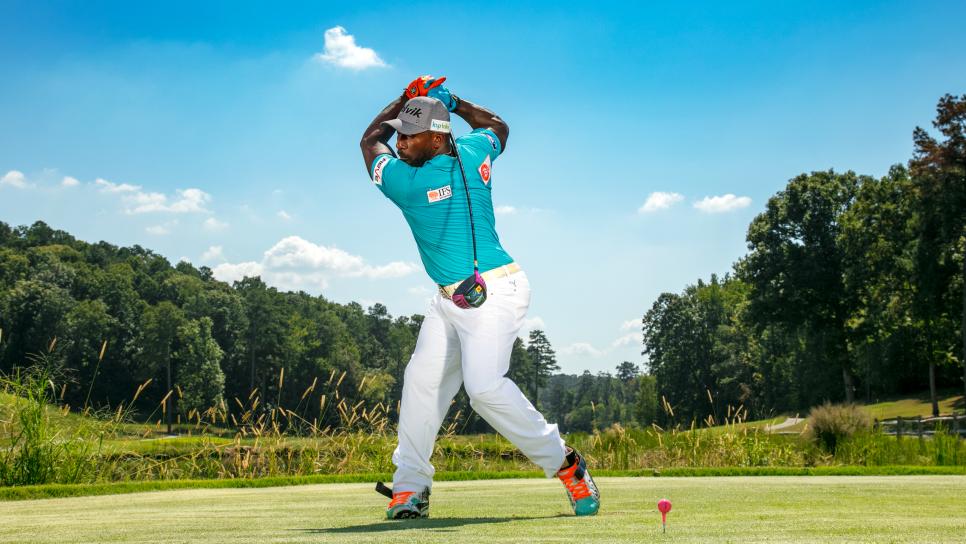Instruction
5 ways to max out your power like a long-drive competitor
You wouldn’t be alone if you wanted to DIY some distance after watching Bryson DeChambeau and the rest of the competitors at last week’s Professional Long Drive world championship. Though intense speed training might not be part of your fitness routine like these long-drivers, there are things we can learn from these monster swings to apply to our game.
Golf Digest Best Young Teacher Paxton O’Connor from Desert Mountain Club in Scottsdale offers some ways to create more speed and power for average players.
The key to your own speed training
Many amateurs have the tendency to subconsciously limit the speed of their swing, worrying about a bad outcome. The key to unlocking more speed, O’Connor says, is simple: Remove the outcome altogether.
“One of the best ways to do this is to make practice swings at max speed without a ball,” O’Connor explains, “Without the fear of a bad result, you will be able to realize your swing speed potential and tap into that additional gear.”

Maurice Allen, former World No. 1-ranked long-drive competitor, ran his own personal-training business for six years—so his fitness regimens are nothing conventional.
Nathaniel Welch
Keep in mind that since you’re swinging at max speed, this should be a shorter rehearsal. O’Connor says to keep it under 10 minutes so you don’t hurt yourself.
O’Connor encourages golfers to use this mind-set whenever they’re working on increasing their distance. “One of the biggest things you can learn from watching the Professional Long Drive players is that their focus isn’t always accuracy,” O’Connor says, “their pursuit is to produce the greatest amount of ball speed.” Keep this in mind and O’Connor says you’ll have more fun during your pursuit for power and distance.
Try a simple setup change
When you watch long-drive competitors set up to the ball, you’ll notice they tee it up really high —sometimes a ball over the top of their driver. You might wonder how such a small adjustment can make such a big difference.
“What you’re trying to optimize is higher launch and low spin,” O’Connor says.
He explains that a high tee helps to encourage a more ascending angle of attack, a key to launching it deep. Next time you’re at the range, test out different tee heights to start hitting up on it.
How to grip it—and then rip it
It might go against everything you’ve been taught, but O’Connor says that gripping the club tighter can help you hit your drives farther.
“We’re often told to grip it lightly, but in reality, none of these long-drivers are holding it like a bird,” he says.
In addition to experimenting with grip pressure, O’Connor recommends focusing on wrist mobility. Improving your wrist mobility will not only prevent injuries, but also strengthen the forearm muscles responsible for your grip and creating clubhead speed.
Making small circles with your wrists is a great way to start working on your wrist mobility. For a more effective stretch, O’Connor says to stabilize your forearm with your opposite hand.
Get faster on the way back
You’ve probably been told to swing easy for a better ball flight, but O’Connor wants to adjust your focus.
“I’d like to shift the paradigm away from thinking you have to take it back slowly with a driver,” O’Connor says.
“Multiple biomechanical studies have proven that a faster backswing leads to more distance,” he continues.
When you practice making a faster backswing, O’Connor says to ensure you’re maintaining your speed through the top of your backswing. Many golfers make the common mistake of slowing down as they get to the top, he says.
High hands for high launch
“A commonality between most of the Professional Long Drive players is that their hands are always way above their head,” O’Connor says, “you’ll even see it from some of the big hitters on tour.”
Higher hands will allow you to create more power and speed through impact. However, O’Connor does caution golfers to test their mobility before trying to make too much of an adjustment.
A good way to test yourself is to rehearse your backswing, as you lift your hands see if you can get them above your head. If you can, O’Connor says you should be good to go!
“A good swing thought to keep in mind as you practice your new backswing is: Hands to the sky,” O’Connor says.
Don’t go in cold
Although you might not see it, almost every professional golfer takes the time to prep their body before they compete. A proper warm-up helps prime the body to swing at higher speeds while reducing the likelihood of an injury.
To maximize the benefit, O’Connor says to identify what warm-ups are best for your body. Whether that means focusing on hip mobility, increasing your flexibility or simply getting your heartrate up, the goal is to get your body ready to move.
If you’re not sure where to start, check out the Golf Digest Schools fitness library to access our golf-specific programs that feature warm-ups from top fitness instructors and tour players.